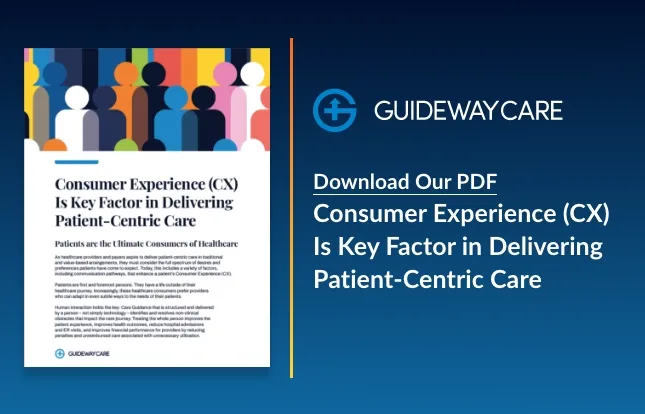Care Guidance Supports Quality Payment Programs in Value-Based Care

While traditional fee-for-service reimbursement models tend to increase the quantity of healthcare services provided, new reimbursement programs have emerged that are changing the way healthcare services are being delivered by rewarding providers for the quality of care they render based upon standardized Value-Based Care (VBC) metrics.
Beginning in 2006, the healthcare industry began a transition from a traditional fee-for-service healthcare model to VBC to advance the “triple aim” of providing better care for individuals, improving population health management strategies and reducing healthcare costs. This is relevant to supporting the same challenges of at-risk patient populations who experience health inequities attributed to Social Determinants of Health (SDOH) and other disparities.
Analysts Laud Value-Based Care
According to a recent study published by McKinsey, VBC offers a higher-touch model than is typically seen in fee-for-service care. Providers spend more time with patients, focusing extensively on personalized, preventive care, condition management, and addressing SDoH. McKinsey analysts assert that providers working in VBC environments have become an attractive market to investors because of the distinctive quality of care that they can provide and the investable opportunity they present, with a diversity of risk levels and business models. By building on a decade of increasing VBC payment adoption—combined with enhanced value-based capabilities across payers, providers, employers and other healthcare stakeholders—continued traction in the VBC market promises to make meaningful inroads in reducing more than $1 trillion of annual waste in US healthcare.
Optimizing Limited Clinical Resources Under Alternative Payment Models
The government is reinforcing its commitment to transition from a traditional fee-for-service healthcare model to VBC and the adoption of alternative payment models — payment approaches that give added incentive payments to provide high-quality and cost-efficient care.
Despite efforts to “sweeten” this shift from volume to value, many providers find it difficult to decide where and how to invest limited resources in order to achieve the best possible operational and financial performance. In some cases, this is the result of provider’ tendencies to under-focus their efforts on barriers embedded in SDoH that can be hard for clinical resources to identify and solve. To ensure quality, cost containment and astute fiscal management of provider at-risk arrangements requires providers understand and identify the SDoH in the communities in which patients live to ensure that quality health care resources can be accessed by everyone.
Added Incentives from CMS
The Centers for Medicare & Medicaid Services (CMS) introduced an array of Quality Payment Programs (QPP) as a valuable component to the Accountable Care Organization (ACO) model, which can consist of groups of doctors, hospitals, and other health care providers, who come together voluntarily to give coordinated high-quality care to Medicare patients. Additional QPP programs include the Merit-Based Incentive Payment System (MIPS) and Alternative Payment Model (APM), giving added incentive payments to providers for their patient scores that reward (or in some cases penalize) for high-quality and cost-efficient care.
Care Guidance is Aligned with QPP Models
Of course, the key to unlocking value from all of these value-based incentives is to find better ways to interact with patients – especially outside the clinic walls and in areas of need that may not directly relate to healthcare. Finding and solving SDoH has proven essential to qualify for many of these value incentives, and well-designed programs that go beyond clinical navigation produce greater savings.
The proposition of care guidance is a perfect extension of QPP models. Now available as a Solution-as-a-Service, highly trained “care guides” operate within a scalable, technology-enabled platform to activate patients and their families and uncover and resolve practical, non-clinical issues and barriers experienced during their care journey. Following structured, AI-assisted workflow protocols ensures that potentially relevant clinical information is also escalated to proper clinical care or social service teams and proactive interventions are promptly initiated by the care guides to resolve non-clinical barriers to care.
Care guidance is validated by results that show a reduction in hospital readmissions and total cost of care, as well as significant improvements in patient appointment attendance, health outcomes, patient experience (CX) and reported satisfaction and quality metrics in VBC arrangements.
For example, care guided patients following an index acute admission indicates that patients who benefit from care guidance (a form on patient activation beyond mere engagement) are significantly less likely to require readmission, revealing significant reductions among targeted conditions. Greater patient adherence has also been observed through care guidance scoring.
Care guides also provide hospitals and health care facilities with value-added support, functioning as an extension of their clinical teams, freeing up labor, time and resources so that nurses and staff can focus on high-value clinical tasks. This improves health care providers’ ability to deliver care centered around their patients, consider their unique needs and delivering care in a way that will generate the best possible patient outcomes and value for all stakeholders.
Care Guidance Supports National Organizations Aimed at Impacting SDoH
Care guidance is meeting the goals of important leaders throughout the industry:
- The newly formed National Alliance to Impact the Social Determinants of Health (NASDOH), a national advocacy organization of healthcare industry stakeholders — both payers and providers — aims to focus national attention on SDoH to improve health and well-being while reducing long term spending on healthcare.
- Care guidance is also helping hospitals achieve optimal HEDIS scores that advance health equity. Published by the National Committee for Quality Assurance (NCQA) for Social Need Screening and Intervention (SNS-E), care guidance implements a multi-point Service as a Solution model to positively impact HEDIS Metrics, CAHPS scores and Medicare Stars Ratings through outbound interactions and the active identification and resolution of healthcare barriers related to SDoH.
- According to NCQA leaders, these new measures are part of an organization-wide effort to advance health equity and encourage health plans to assess and address the food, housing and transportation needs of their member populations.
Alternative Payment Models Draw Legislative Support
There is bipartisan agreement that Alternative Payment Models (APMs) are a key solution to helping at-risk seniors receive better care at a lower cost. Two U.S. Senators, Sheldon Whitehouse, D-R.I., and Dr. John Barrasso, R-Wyo., have introduced legislation entitled the Preserving Access to Value-Based Care Act. With expected bipartisan support, this bill seeks to extend a 5% advanced alternative payment model incentive that will cover participating providers for an additional two years and ensuring that qualification thresholds remain at attainable levels for practices that participate in Medicare’s advanced APMs. The Health Care Payment Learning and Action Network (LAN) recently released the results of its calendar year Alternative Payment Model (APM) survey which showed that on average, 40% of US healthcare payments flowed through advanced payment models across all payer types.
The Advanced APM program is critical in Medicare’s continued transition to VPC, ensuring that Medicare offers the incentivized support providers need. The passage of this bill will send a clear signal that APMs are here to stay in the Medicare program.
Guiding the Future of Equitable Healthcare
A care guidance solution requires collaboration with like-minded partners dedicated to improving the health and welfare of entire communities. As your partner, Guideway delivers on the promise of health equity in Value-Based Care environments.
Please contact us if you have questions or need support.
Contact Us Today To Learn How We Can Help
"*" indicates required fields




